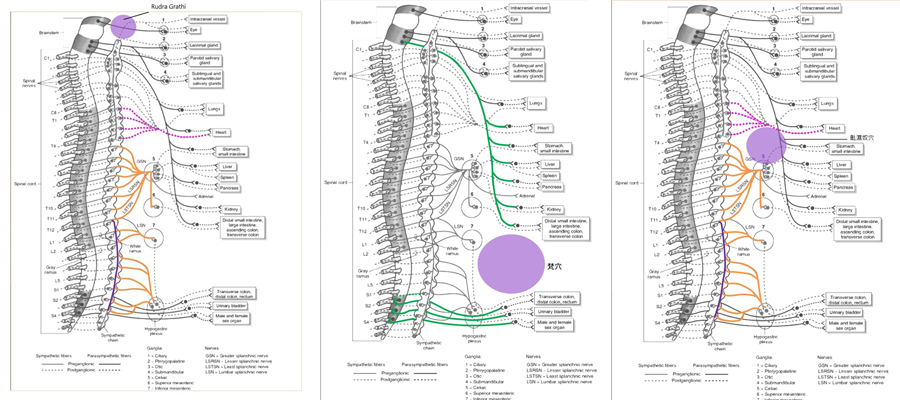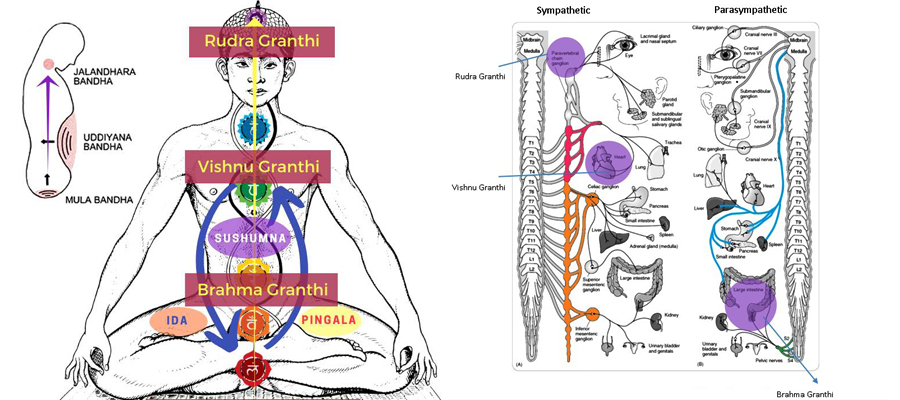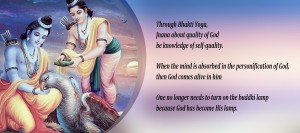In Kundalini Yoga, it is said that there are three Granthi can be responsible for preventing prana from rising up through Sushumna Nadi. This Granthi three knots prevent one’s full potential from Kundalini rising energy. These three knots are Brahma Granthi, Vishnu Granthi and Rudra Granthi. They also relate to the Prakritis three Gunas (Tamas, Rajas and Sattva).
Some yogis in yoga see Granthi as a bamboo tree, where each segment is a barrier or barrier to the increase in kundalini energy.
The chakras in the psycho-physical human body at the dormant state form complex intertwined structures, called Granthi, or knots, as they are “link” matter and spirit, enhancing the sense of ego. There are three main granthis in the human body, which make the trinity of Brahma, Vishnu, and Shiva respectively, and they are called Brahma Granthi, Vishnu Granthi and Rudra Granthi.
In any practice to achieve success in the process of Kundalini awakening it is important to open these psychic knots. However, it is quite difficult because of granthi inextricably connected with all that we are accustomed to thinking of our personality, our habits, qualities, desires.
Three granthis together constitute the unconscious complexes (samskara) woven by illusion, and the weight and rigidity of the past is strong opposition to the passage of spiritual power.
The three Granthi are :
- Brahma granthi. it covers the area of Mulahara and Svadhisthan chakras. Some call it the perineal knot. It relates to the Tamas Guna (Mulahara and Svadhishthana) the universal destructive power.
In both the Jabal and the Yogashikha Upanishad state that this granthi is located in the Muladhard chakra. However, most tantric scriptures place it in the Manipura chakra. - Vishnu granthi (doing and prana). It covers the area between Manipura, Anahata and Vishuddi chakras. Sometimes it is known as the navel knot. It relates to the Rajas Guna (Manipura and Anahata) – the universal power of motion and activity.
Vishnu granthi is said to be located in the area of Anahata chakra (the heart center), which is also the seat of prana. The heart is also the major knot chakra. So, to take the Kundalini Shakti into the passage of the Sushumna through Anahata chakra is also not very easy. - Rudra granthi (Jnana, true knowledge). It covers the areas of Ajna and Sahasrara chakras. It is also known as the forehead knot. Unlike the other five chakras, the Ajna chakra is not connected to the spinal cord. So, the Rudra granthi is blocking the flow of prana beyond the sixth chakra between the eyebrows, Ajna chakra, upwards toward Sahasrara. It relates to the Sattva Guna (Vishuddha and Ajna), the universal creative power.
The Brahma granthi separates the first two chakras (Mulahra and Suadhisthana chakras) from the Manipura chakra. The sympathetic chain is continuous, however, at the upper level of the splanchnic nerves, the presynaptic system changes to the post-synaptic system. So, one can say the Vishnu Granthi is between the Manipura and the Anahata chakras.
Brahma Granthi is the first major block that sadhaka need to transcend. This granthi keeps a person under the illusion of the material benefits, physical pleasures, lethargy, ignorance, and uncertainty.
Among all the most powerful is an illusion of physical pleasure. This granthi plays an important role because it is responsible for the material man’s thinking. It creates a kind of attraction in the nature of the human mind.
Brahma granthi is covered by the essence it produces. This essence is called as “Kledam”. It is colorless and smells as a lotus flower. It is like a mixture of ‘Kapha’ which covers the entrance of Sushumna and also lubricates the Nadi connected. This lubrication helps the pulses of Nadi.
This Kledam is a thick mixture and thickens when we get older if we don’t practice yoga. With the power of Yoga can penetrate this barrier and go up through Sushumna through each barrier.

In short, anatomically the Granthis exist due to either the change of systems from sympathetic to parasympathetic, the separation of Vagus nerve from the Sacral nerve, or the changes from presynaptic fibers to postsynaptic fibers.
The philosophy of Kundalini Yoga is associated with the flow of energy in the channels called Ida and Pingala, (the female and male channels of the astral body, comparable to the sensory and motor nerves of the physical body) and its criss-cross centers in the spinal canal called Sushumna Nadi called chakras.
The three major intersections in the central Sushumna Nadi are at Muladhara (pelvic region), Anahata (chest region) and Ajna chakras (between the eyebrows) are interpreted as Granthi because the exchange energies of physical and mental levels occur at these three places and named after the Trinity.
Granthi means a knotted area which prevents the free flow of energy (Prana) from rising upwards. The concept and explanations related to granthi is a vague term that deals with very internal issues of undoing it and hard to give a figurative expression in a stone medium because they are levels of awareness where the power of Maya, ignorance, and attachment to material things are especially strong.
According to ancient spiritual science, every human has a gross physical body, the subtle astral body, and mind as its counterpart which is linked to each other. Though mind resides and interacts in the physical body, it cannot be given proof for its structure nor location in the body, but the mind influences the astral body also. The energy for the physical body is through external aids, but, energy for the astral body is dependent on the calm state of mind which can be achieved by getting out of the worldly entanglements termed as granthi.
The Ida and Pingala Nadi that are like spirals of opposite poles of the central axis intertwine and unlock while passing through the seven chakras. Psychic knots of granthis are like protective blockages for the gradual change in awareness and open only with the purification of mind and balance between the two Nadi. The purpose of granthis is to block the sudden upward flow of prana, are like circuit breakers to protect the overload that may occur to the practitioner in case of a spontaneous ascension. The display of ‘granthis’ is associated with the ‘Trinity’ as the three main deities (Tri Murti).
They are visualized like psychic knots or obstacles on the path of the awakened kundalini, (The power of awareness) which is difficult to pass through for every human, as it brings about a change in personality. Each aspirant must transcend these barriers to make a clear passageway for the ascending kundalini. In tantra based sculptures, the two major components Nadi, Ida and Pingala of kundalini as are pictured in anthropomorphic form as male and female human figures and crisscross is indicated as in contact or the hand positioned in the specific region of chakra.
In sculptural representations of this topic, the figures, since it is related to mind, the core of ‘Chitta’, are usually presented in a nude form, as the bare body represents the unadorned form of mind. In symbolic representations, they are like male and female snakes coiling at three places. The psychic Knots of granthi is depicted in the symbolized form as the Shiva Linga symbol. Different temples use different motifs to convey this topic in sculptures. The two sculptural representations are:





